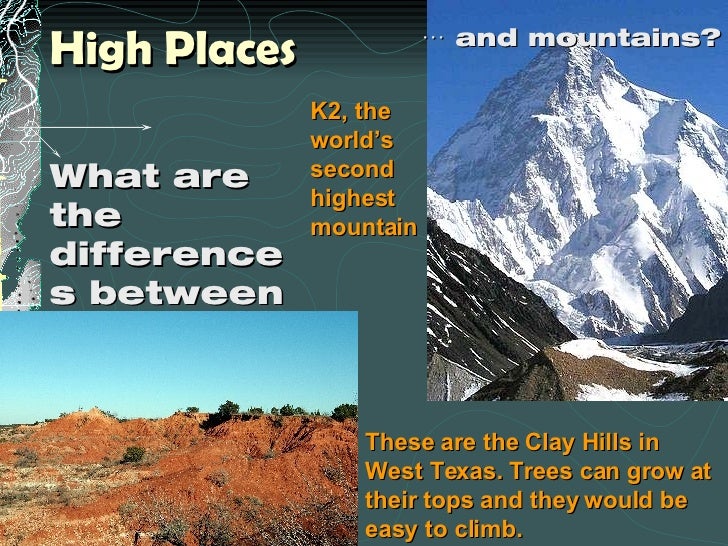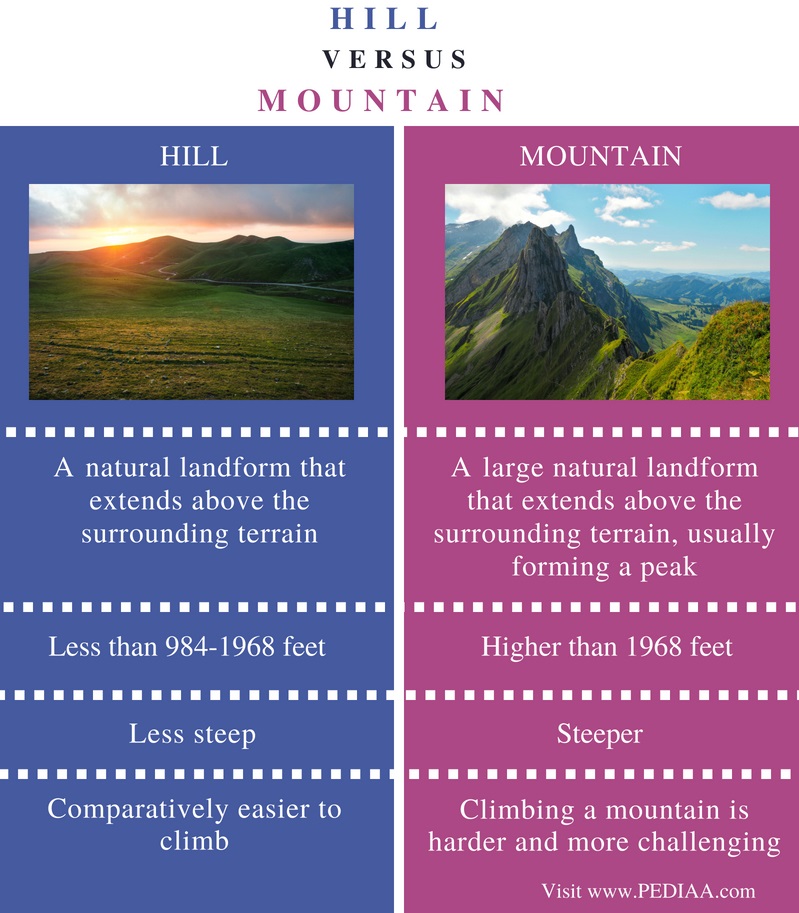The Difference Between Hills and Mountains: An Overview
Hills and mountains are both natural landforms that rise above the surrounding terrain, but the distinction between them is not always clear-cut. The terms ‘hill’ and ‘mountain’ are often used interchangeably, but they have distinct characteristics that can help differentiate them. The primary factors influencing this distinction include elevation, slope, and regional definitions. Understanding the difference between hills and mountains can enhance outdoor experiences, contribute to geographical literacy, and foster a greater appreciation for the natural world.
Elevation: A Key Factor in Determining a Mountain
Elevation is a crucial factor in distinguishing between hills and mountains. Generally, mountains have a higher elevation than hills. However, the specific elevation threshold that separates hills from mountains varies across organizations and countries. The commonly used 1,000-foot (300-meter) rule is a widely accepted benchmark, but it has limitations. For instance, some hills with elevations below 1,000 feet (300 meters) can still be considered mountains due to their steep slopes and significant prominence.
In the United States, the United States Geological Survey (USGS) defines a mountain as a landform that rises at least 1,000 feet (300 meters) above its surrounding area. However, in the United Kingdom, the Ordnance Survey (OS) considers any summit with an elevation of 500 feet (152 meters) or more and a drop of at least 150 feet (46 meters) on all sides to be a mountain. These varying definitions demonstrate how elevation is just one factor in determining whether a landform is a hill or a mountain.
Slope and Prominence: Additional Criteria for Classification
While elevation is an essential factor, slope and prominence also play crucial roles in differentiating between hills and mountains. Slope refers to the angle or gradient of a landform’s surface, while prominence indicates the height difference between a peak and the lowest contour line encircling it without crossing any higher peaks.
For example, Mount Fuji in Japan, with an elevation of 12,389 feet (3,776 meters), is undoubtedly considered a mountain. However, Mauna Kea in Hawaii, which has an elevation of 13,796 feet (4,205 meters), is sometimes classified as a hill due to its gentle slope and relatively low prominence compared to its base on the ocean floor. Similarly, the famous Matterhorn, with an elevation of 14,692 feet (4,478 meters), is considered a mountain, despite having a lower elevation than Mauna Kea, because of its steep slopes and significant prominence.
Geographical and Cultural Differences in Defining Hills and Mountains
Regional variations and cultural perceptions significantly influence the definitions of hills and mountains. For instance, in the Swiss Alps, a peak below 3,000 meters (9,842 feet) may be considered a hill, whereas in the Himalayas, such a peak would undoubtedly be classified as a mountain. Similarly, in the Scottish Highlands, any landform over 1,500 feet (457 meters) is considered a mountain, reflecting the region’s unique geographical context.
In some cases, cultural and historical factors also play a role in defining hills and mountains. For example, Mount Tamalpais in California, which stands at 2,571 feet (784 meters), is considered a mountain by the local indigenous people, the Coast Miwok, due to its spiritual significance. Meanwhile, the German language uses the term “Berg” for any sizable landform, regardless of its elevation, while “Hügel” is used for smaller hills.
How to Identify a Mountain: Practical Tips and Guidelines
To determine whether a landform is a hill or a mountain, consider the following practical advice and guidelines:
- Research local definitions: Consult regional geographical authorities, maps, and guides to understand how hills and mountains are defined in the area you are exploring.
- Use elevation, slope, and prominence measurements: While elevation alone might not provide a clear answer, combining it with slope and prominence can help you make a more informed decision. For instance, a landform with an elevation of 900 feet (274 meters) and a steep slope of 30 degrees, as well as a prominence of 500 feet (152 meters), is likely a mountain.
- Consider the context: The surrounding landscape and the landform’s relative height can provide valuable context. For example, a 1,500-foot (457-meter) peak in a region with generally low elevations might be considered a mountain, while the same elevation in a mountainous area might be classified as a hill.
- Learn from local experts: Speak with park rangers, hiking guides, or knowledgeable locals who can share their insights and help you better understand the distinctions between hills and mountains in the area.
The Significance of the Distinction: Why It Matters
Understanding the difference between hills and mountains can have several practical implications for outdoor enthusiasts, geographical literacy, and environmental stewardship. By familiarizing yourself with the defining characteristics of these landforms, you can:
- Enhance your outdoor experiences: Knowing whether you are hiking a hill or a mountain can help you better prepare for the challenges and conditions you may encounter. For instance, mountains often have more extreme weather, steeper terrain, and a greater risk of altitude sickness than hills.
- Contribute to geographical literacy: Recognizing the distinctions between hills and mountains can deepen your understanding of geographical concepts and terminology. This knowledge can help you better appreciate the diverse landscapes found around the world and foster a greater connection to the natural environment.
- Foster a greater appreciation for the natural world: By learning to identify and classify landforms, you can develop a deeper appreciation for the unique features and characteristics that shape our planet. This knowledge can inspire a sense of wonder and curiosity about the natural world, encouraging you to explore, learn, and protect these precious landscapes for future generations.
Exploring Famous Hills and Mountains: Case Studies and Examples
To better illustrate the complexities and nuances of distinguishing between hills and mountains, let’s examine some famous landforms and how their classification reflects regional definitions, cultural perceptions, and geographical contexts:
- Mauna Kea, Hawaii, USA: With an elevation of 13,796 feet (4,205 meters), Mauna Kea is taller than Mount Everest when measured from its base on the ocean floor to its summit. However, due to its gentle slopes and relatively low prominence compared to its base, it is sometimes considered a hill according to specific definitions. In practice, though, it is widely acknowledged as a mountain.
- Mount Fuji, Japan: As the highest peak in Japan, Mount Fuji stands at 12,389 feet (3,776 meters) and is widely recognized as a mountain. However, its symmetrical cone shape and gentle slopes make it an exceptional example of a stratovolcano, showcasing how a mountain can also possess unique features that set it apart from other landforms.
- Signal Hill, Cape Town, South Africa: Signal Hill, with an elevation of 1,283 feet (391 meters), is a prominent landform in Cape Town, offering stunning views of the city and the surrounding landscape. Despite its significant height, it is considered a hill due to its relatively low elevation compared to the nearby Table Mountain, which stands at 3,558 feet (1,084 meters) and is classified as a mountain.
Embracing the Spectrum of Landforms: From Hills to Mountains
As you’ve discovered throughout this article, the distinction between hills and mountains is not always clear-cut. Various factors, such as elevation, slope, prominence, regional definitions, and cultural perceptions, all contribute to the classification of these landforms. By understanding this complexity, you can:
- Appreciate the unique characteristics and challenges of both hills and mountains: Each landform offers its own set of rewards and challenges for outdoor enthusiasts. By embracing the spectrum of landforms that exists between hills and mountains, you can deepen your connection with the natural world and expand your horizons as a hiker, climber, or nature lover.
- Recognize the importance of local knowledge and context: When exploring a new region or landscape, take the time to learn about the local definitions and classifications of hills and mountains. This knowledge will not only enhance your understanding of the area but also help you better appreciate the unique features and characteristics that shape the region.
- Celebrate the diversity of our planet’s landscapes: From the gentle slopes of rolling hills to the towering peaks of majestic mountains, our planet is home to a breathtaking array of landforms. By embracing the spectrum of hills and mountains, you can cultivate a deeper appreciation for the natural beauty and diversity of our world.








